The NVIDIA GeForce GTX 980 Review: Maxwell Mark 2
by Ryan Smith on September 18, 2014 10:30 PM ESTPower, Temperature, & Noise
As always, last but not least is our look at power, temperature, and noise. Next to price and performance of course, these are some of the most important aspects of a GPU, due in large part to the impact of noise. All things considered, a loud card is undesirable unless there’s a sufficiently good reason – or sufficiently good performance – to ignore the noise.
Having already seen the Maxwell architecture in action with the GTX 750 series, the GTX 980 and its GM204 Maxwell 2 GPU have a very well regarded reputation to live up to. GTX 750 Ti shattered old energy efficiency marks, and we expect much the same of GTX 980. After all, NVIDIA tells us that they can deliver more performance than the GTX 780 Ti for less power than the GTX 680, and that will be no easy feat.
| GeForce GTX 980 Voltages | ||||
| GTX 980 Boost Voltage | GTX 980 Base Voltage | GTX 980 Idle Voltage | ||
| 1.225v | 1.075v | 0.856v | ||
We’ll start as always with voltages, which in this case I think makes for one of the more interesting aspects of GTX 980. Despite the fact that GM204 is a pretty large GPU at 398mm2 and is clocked at over 1.2GHz, NVIDIA is still promoting a TDP of just 165W. One way to curb power consumption is to build a processor wide-and-slow, and these voltage numbers are solid proof that NVIDIA has not done that.
With a load voltage of 1.225v, NVIDIA is driving GM204 as hard (if not harder) than any of the Kepler GPUs. This means that all of NVIDIA’s power optimizations – the key to driving 5.2 billion transistors at under 165W – lie with other architectural optimizations the company has made. Because at over 1.2v, they certainly aren’t deriving any advantages from operating at low voltages.
Next up, let’s take a look at average clockspeeds. As we alluded to earlier, NVIDIA has maintained the familiar 80C default temperature limit for GTX 980 that we saw on all other high-end GPU Boost 2.0 enabled cards. Furthermore as a result of reinvesting most of their efficiency gains into acoustics, what we are going to see is that GTX 980 still throttles. The question then is by how much.
| GeForce GTX 980 Average Clockspeeds | |||
| Max Boost Clock | 1252MHz | ||
| Metro: LL |
1192MHz
|
||
| CoH2 |
1177MHz
|
||
| Bioshock |
1201MHz
|
||
| Battlefield 4 |
1227MHz
|
||
| Crysis 3 |
1227MHz
|
||
| TW: Rome 2 |
1161MHz
|
||
| Thief |
1190MHz
|
||
| GRID 2 |
1151MHz
|
||
| Furmark |
923MHz
|
||
What we find is that while our GTX 980 has an official boost clock of 1216MHz, our sustained benchmarks are often not able to maintain clockspeeds at or above that level. Of our games only Bioshock Infinite, Crysis 3, and Battlefield 4 maintain an average clockspeed over 1200MHz, with everything else falling to between 1151MHz and 1192MHz. This still ends up being above NVIDIA’s base clockspeed of 1126MHz – by nearly 100MHz at times – but it’s clear that unlike our 700 series cards NVIDIA is much more aggressively rating their boost clock. The GTX 980’s performance is still spectacular even if it doesn’t get to run over 1.2GHz all of the time, but I would argue that the boost clock metric is less useful this time around if it’s going to overestimate clockspeeds rather than underestimate. (ed: always underpromise and overdeliver)
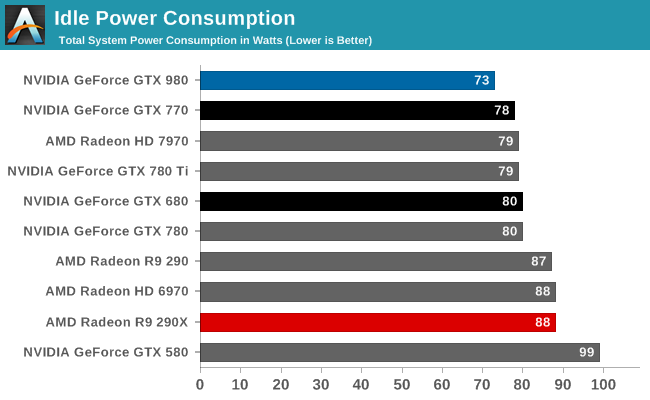
Starting as always with idle power consumption, while NVIDIA is not quoting specific power numbers it’s clear that the company’s energy efficiency efforts have been invested in idle power consumption as well as load power consumption. At 73W idle at the wall, our testbed equipped with the GTX 980 draws several watts less than any other high-end card, including the GK104 based GTX 770 and even AMD’s cards. In desktops this isn’t going to make much of a difference, but in laptops with always-on dGPUs this would be helpful in freeing up battery life.

Our first load power test is our gaming test, with Crysis 3. Because we measure from the wall, this test means we’re seeing GPU power consumption as well as CPU power consumption, which means high performance cards will drive up the system power consumption numbers merely by giving the CPU more work to do. This is exactly what happens in the case of the GTX 980; at 304W it’s between the GK104 based GTX 680 and GTX 770, however it’s also delivering 30% better framerates. Accordingly the power consumption of the GTX 980 itself should be lower than either card, but we would not see it in a system power measurement.
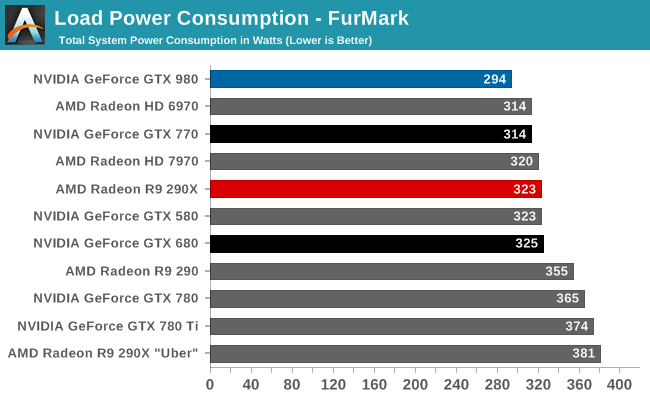
For that reason, when looking at recent generation cards implementing GPU Boost 2.0 or PowerTune 3, we prefer to turn to FurMark as it essentially nullifies the power consumption impact of the CPU. In this case we can clearly see what NVIDIA is promising: GTX 980’s power consumption is lower than everything else on the board, and noticeably so. With 294W at the wall, it’s 20W less than GTX 770, 29W less than 290X, and some 80W less than the previous NVIDIA flagship, GTX 780 Ti. At these power levels NVIDIA is essentially drawing the power of a midrange class card, but with chart-topping performance.
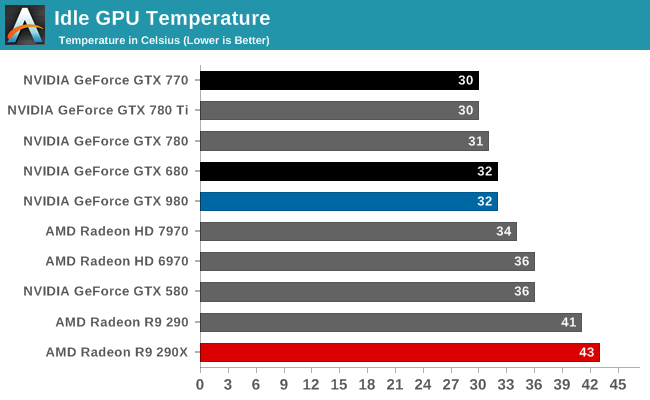
Moving on to temperatures, at idle we see nothing remarkable. All of these well-designed, low idle power designs are going to idle in the low 30s, especially since they’re not more than a few degrees over room temperature.

With an 80C throttle point in place for the GTX 980, it’s here where we see the card top out at. The fact that we’re hitting 80C is the reason why the card is exhibiting clockspeed throttling as we saw earlier. NVIDIA’s chosen fan curve is tuned for noise over temperature, so it’s letting the GPU reach its temperature throttle point rather than ramp up the fan (and the noise) too much.
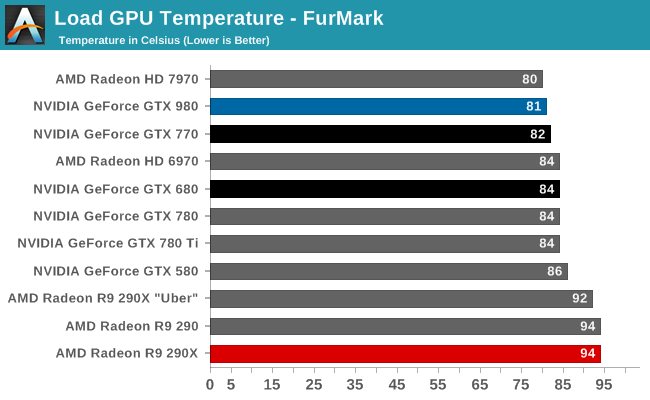
Once again we see the 80C throttle in action. Like all GPU Boost 2.0 NVIDIA cards, NVIDIA makes sure their products aren’t going to get well over 80C no matter the workload.
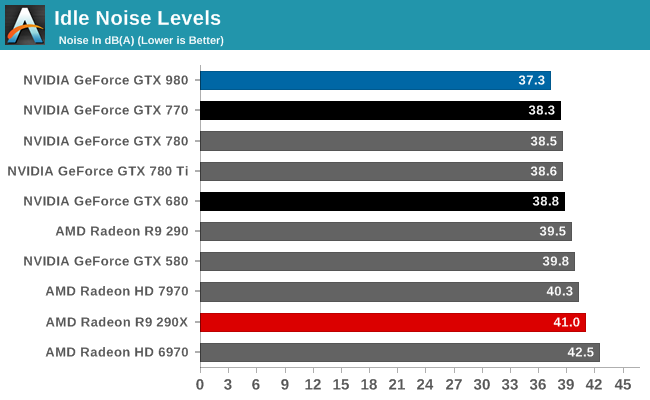
Last but not least we have our noise results. Right off the bat the GTX 980 is looking strong; even with the shared heritage of the cooler with the GTX 780 series, the GTX 980 is slightly but measurably quieter at idle than any other high-end NVIDIA or AMD card. At 37.3dB, the GTX 980 comes very close to being silent compared to the rest of the system.

Our Crysis 3 load noise testing showcases the full benefits of the GTX 980’s well-built blower in action. GTX 980 doesn’t perform appreciably better than the GTX Titan cooler equipped GTX 770 and GTX 780, but then again GTX 980 is also not using quite as advanced of a cooler (forgoing the vapor chamber). Still, this is enough to edge ahead of the GTX 770 by 0.1dB, technically making it the quietest video card in this roundup. Though for all practical purposes, it’s better to consider it tied with the GTX 770.

FurMark noise testing on the other hand drives a wedge between the GTX 980 and all other cards, and it’s in the GTX 980’s favor. Despite the similar noise performance between various NVIDIA cards under Crysis 3, under our maximum, pathological workload of FurMark the GTX 980 pulls ahead thanks to its 165W TDP. At the end of the day its lower TDP limit means that the GTX 980 never has too much heat to dissipate, and as a result it never gets too loud. In fact it can’t. 48.1dB is as loud as the GTX 980 can get, which is why the GTX 980’s cooler and overall build are so impressive. There are open air cooled cards that now underperform the GTX 980 that can’t hit these low of noise levels, never mind the other cards with blowers.
Between the GTX Titan and its derivatives and now GTX 980, NVIDIA has spent quite a bit of time and effort on building a better blower, and with their latest effort it really shows. All things considered we prefer blower type coolers for their heat exhaustion benefits – just install it and go, there’s almost no need to worry about what the chassis cooling can do – and with NVIDIA’s efforts to build such a solid cooler for a moderately powered card, the end result is a card with a cooler that offers all the benefits of a blower with the acoustics that can rival and open air cooler. It’s a really good design and one of our favorite aspects of GTX Titan, its derivatives, and now GTX 980.










274 Comments
View All Comments
TheJian - Saturday, September 20, 2014 - link
http://blogs.nvidia.com/blog/2014/09/19/maxwell-an...Did I miss it in the article or did you guys just purposely forget to mention NV claims it does DX12 too? see their own blog. Microsoft's DX12 demo runs on ...MAXWELL. Did I just miss the DX12 talk in the article? Every other review I've read mentions this (techpowerup, tomshardware, hardocp etc etc). Must be that AMD Center still having it's effect on your articles ;)
They were running a converted elemental demo (converted to dx12) and Fable Legends from MS. Yet curiously missing info from this site's review. No surprise I guess with only an AMD portal still :(
From the link above:
"Part of McMullen’s presentation was the announcement of a broadly accessible early access program for developers wishing to target DX12. Microsoft will supply the developer with DX12, UE4-DX12 and the source for Epic’s Elemental demo ported to run on the DX12-based engine. In his talk, McMullen demonstrated Maxwell running Elemental at speed and flawlessly. As a development platform for this effort, NVIDIA’s GeForce GPUs and Maxwell in particular is a natural vehicle for DX12 development."
So maxwell is a dev platform for dx12, but you guys leave that little detail out so newbs will think it doesn't do it? Major discussion of dx11 stuff missing before, now up to 11.3 but no "oh and it runs all of dx12 btw".
One more comment on 980: If it's a reference launch how come other sites already have OC versions (IE, tomshardware has a Windforce OC 980, though stupidly as usual they downclocked it and the two OC/superclocked 970's they had to ref clocks...ROFL - like you'd buy an OC card and downclock them)? IT seems to be a launch of OC all around. Newegg even has them in stock (check EVGA OC version):
http://www.newegg.com/Product/Product.aspx?Item=N8...
And with a $10 rebate so only $559 and a $5 gift card also.
"This model is factory overclocked to 1241 MHz Base Clock/1342 MHz Boost Clock (1126 MHz/1216 MHz for reference design)"
Who would buy ref for $10 diff? IN fact the ref cards are $569 at newegg, so you save buying the faster card...LOL.
cactusdog - Saturday, September 20, 2014 - link
TheJian, Wow, Did you read the article? Did you read the conclusion? AT says the 980 is "remarkable" , "well engineered", "impeccable design" and has "no competition" They covered almost all of Nvidia marketing talking points and you're going to accuse them of a conspiracy? Are you fking retarded??Daniel Egger - Saturday, September 20, 2014 - link
It would be nice to rather than just talk about about the 750 Ti to also include it in comparisons to see it clearer in perspective what it means to go from Maxwell I to Maxwell II in terms of performance, power consumption, noise and (while we are at it) performance per Watt and performance per $.Also where're the benchmarks for the GTX 970? I sure respect that this card is in a different ballpark but the somewhat reasonable power output might actually make the GTX 970 a viable candidate for an HTPC build. Is it also possible to use it with just one additional 6 Pin connector (since as you mentioned this would be within the specs without any overclocking) or does it absolutely need 2 of them?
SkyBill40 - Saturday, September 20, 2014 - link
As was noted in the review at least twice, they were having issues with the 970 and thus it won't be tested in full until next week (along with the 980 in SLI).MrSpadge - Saturday, September 20, 2014 - link
Wow! This makes me upgrade from a GTX660Ti - not because of gaming (my card is fast enough for my needs) but because of the power efficiency gains for GP-GPU (running GPU-Grid under BOINC). Thank you nVidia for this marvelous chip and fair prices!jarfin - Saturday, September 20, 2014 - link
i still CANT understand amd 'uber' option.its totally out of test,bcoz its just 'oc'd' button,nothing else.
its must be just r290x and not anantech 'amd canter' way uber way.
and,i cant help that feeling,what is strong,that anatech is going badly amd company way,bcoz they have 'amd center own sector.
so,its mean ppl cant read them review for nvidia vs radeon cards race without thinking something that anatech keep raden side way or another.
and,its so clear thats it.
btw
i hope anantech get clear that amd card R9200 series is just competition for nvidia 90 series,bcoz that every1 kow amd skippedd 8000 series and put R9 200 series for nvidia 700 series,but its should be 8000 series.
so now,generation of gpu both side is even.
meaning that next amd r9 300 series or what it is coming amd company battle nvidia NEXT level gpu card,NOT 900 series.
there is clear both gpu card history for net.
thank you all
p.s. where is nvidia center??
Gigaplex - Saturday, September 20, 2014 - link
Uber mode is not an overclock. It's a fan speed profile change to reduce thermal throttling (underclock) at the expense of noise.dexgen - Saturday, September 20, 2014 - link
Ryan, Is it possible to see the average clock speeds in different tests after increasing the power and temperature limit in afterburner?And also once the review units for non-reference cards come in it would be very nice to see what the average clock speeds for different cards with and without increased power limit would be. That would be a great comparison for people deciding which card to buy.
silverblue - Saturday, September 20, 2014 - link
Exceptional by NVIDIA; it's always good to see a more powerful yet more frugal card especially at the top end.AMD's power consumption could be tackled - at least partly - by some re-engineering. Do they need a super-wide memory bus when NVIDIA are getting by with half the width and moderately faster RAM? Tonga has lossless delta colour compression which largely negates the need for a wide bus, although they did shoot themselves in the foot by not clocking the memory a little higher to anticipate situations where this may not help the 285 overcome the 280.
Perhaps AMD could divert some of their scant resources towards shoring up their D3D performance to calm down some of the criticism because it does seem like they're leaving performance on the table and perhaps making Mantle look better than it might be as a result.
Luke212 - Saturday, September 20, 2014 - link
Where are the SGEMM compute benchmarks you used to put on high end reviews?